
Carpenter Gothic, also sometimes called Carpenter's Gothic or Rural Gothic, is a North American architectural style-designation for an application of Gothic Revival architectural detailing and picturesque massing applied to wooden structures built by house-carpenters. The abundance of North American timber and the carpenter-built vernacular architectures based upon it made a picturesque improvisation upon Gothic a natural evolution. Carpenter Gothic improvises upon features that were carved in stone in authentic Gothic architecture, whether original or in more scholarly revival styles; however, in the absence of the restraining influence of genuine Gothic structures, the style was freed to improvise and emphasize charm and quaintness rather than fidelity to received models. The genre received its impetus from the publication by Alexander Jackson Davis of Rural Residences and from detailed plans and elevations in publications by Andrew Jackson Downing.

The American Gothic House, also known as the Dibble House, is a house in Eldon, Iowa, designed in the Carpenter Gothic style with a distinctive upper window. It was the backdrop of the 1930 painting American Gothic by Grant Wood, generally considered Wood's most famous work and among the most recognized paintings in twentieth century American art. Wood, who observed the house only twice in his lifetime, made only an initial sketch of the house—he completed American Gothic at his studio in Cedar Rapids.

The Charles Capron House is an historic house at 2 Capron Street in Uxbridge, Massachusetts. Built in 1874, it is an locally distinguished example of Gothic Revival architecture. It is also notable for its association with Charles Capron, a local mill owner. The house was listed on the National Register of Historic Places in 1983.

The Birches is a house at the southeast corner of the junction of NY 9D and 403 in the hamlet of Garrison, New York, United States. It was built for William H. Osborn, as part of his nearby Wing & Wing estate, by architect Ralph Adams Cram in the Gothic Revival architectural style. Osborn was a 19th-century railroad tycoon, who became one of the most prominent railroad leaders in the United States. In addition to Wing and Wing and the Birches, Osborn famously constructed Castle Rock, his great summer estate overlooking the Hudson River.
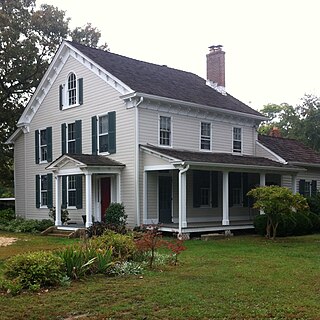
The old St. Mary's Rectory is a gable-front 21⁄2-story frame dwelling of three by three bays, built in 1849 and enlarged to twice its size in 1856, and located in Aquasco, Prince George's County, Maryland. The structure is significant for its architecture and for its association with the history of St. Paul's Parish and the community of Aquasco. The rectory is an excellent example of a vernacular building with Greek Revival and Italianate stylistic elements. The floor plan exemplifies a style typical of the dwellings of successful landowners and merchants of the mid-19th century in Prince George's County. Original Greek Revival style elements include the front gable entrance facade, crown molded returned cornice, porch detail, interior stair detail, door and window surrounds, and the parlor mantel. Italianate elements include the heavy bracketing of the exterior cornice and the tripartite window in the north gable end.

Clarkson Chapel is located on New York State Route 9G in Clermont, New York, United States, just across from the Coons House. It is a mid-19th century wooden building in the Carpenter Gothic style.

The house at 184 Albany Avenue in Kingston, New York, United States, is a frame building in the Picturesque mode of the Gothic Revival architectural style. It was built around 1860.

Old Episcopal Manse is a historic Episcopal manse building on New York State Route 23, Main Street in Prattsville, Greene County, New York. It was built about 1845 and is a 1+1⁄2-story, cross-gable house type with Gothic Revival style features. It features board and batten siding and a steeply pitched gable roof. Also on the property is a carriage house, also built about 1845.
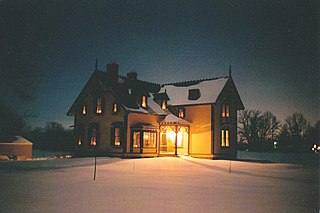
The Nicholson–Rand House is a historic house located in Decatur Township, Marion County, Indiana, in Indianapolis. It was moved half a mile south by the Historic Landmarks Foundation of Indiana (HLFI) to save it from being demolished in 1997 and added to the National Register of Historic Places (NRHP) in 2003. The house is an example of the Gothic Revival style of American architecture typified by Alexander Jackson Davis and Andrew Jackson Downing in the mid-19th century.

Echo Lawn Estate, also known as Stonegate after the Great War, is a historic estate located at Balmville in Orange County, New York. The main house was built about 1860 and is a two-story brick dwelling in the Second Empire style. It features sweeping concave mansard-type roofs. Also on the property is a cluster of mid-19th-century service buildings, an early 20th-century formal garden, and a substantial set of Arts and Crafts inspired gateposts and stone walls.

The John Littig House is a historic building located on the northwest side of Davenport, Iowa, United States. The Gothic Revival style residence was built in 1867 and has been listed on the National Register of Historic Places since 1984 and on the Davenport Register of Historic Properties since 1993.
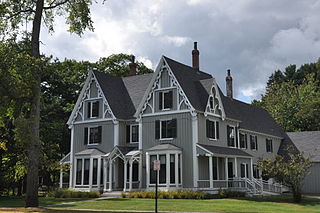
The Henry Boody House also known as the Boody-Johnson House, is an historic house at 256 Maine Street in Brunswick, Maine, United States. Built in 1849, it is an important early example of Gothic Revival Architecture, whose design was published by Andrew Jackson Downing in 1850 and received wide notice. It was listed on the National Register of Historic Places on 1975.

The George M. Brown House is a historic residence in Provo, Utah, United States, that is listed on the National Register of Historic Places. It was built as a home for a "polygamous wife" of lawyer George M. Brown. It is listed on the National Register of Historic Places.

The William Sauntry House and Recreation Hall is a historic property in Stillwater, Minnesota, United States, consisting of a late-nineteenth-century house and a 1902 addition styled after a Moorish palace. It was listed on the National Register of Historic Places in 1982 for its local significance in the themes of architecture and industry. It was nominated for its association with prosperous local lumberman William Sauntry (1845–1914) and for its fanciful recreation hall, one of Minnesota's best examples of a folly and a rare use of Moorish Revival architecture. Now in separate ownership, the recreation hall has been restored as a private home while the William Sauntry Mansion operates as a bed and breakfast.

The Godfrey-Kellogg House is a historic house at 212 Kenduskeag Road in Bangor, Maine, USA. Built in about 1847, it is one of the state's finest and least-altered examples of residential Gothic Revival architecture. It was listed on the National Register of Historic Places in 1973.
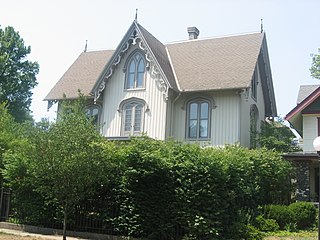
The Horatio Chapin House, or simply, the Chapin House, is a historic home located at South Bend, St. Joseph County, Indiana. It was built between 1855 and 1857 by Horatio Chapin, one of the early settlers of South Bend and the first president of the board of town trustees. The house consists of a 2+1⁄2-story, cross-plan, Gothic Revival style frame dwelling, a rare example of its kind in the region. It's considered an outstanding example of Gothic Revival architecture influenced by architect Andrew Jackson Downing. It is sheathed in board and batten siding and features lancet windows and a steeply pitched cross-gable roof with an elaborately carved bargeboard. The Chapin House is widely recognized as one of the most significant homes in the state of Indiana, and in 1980 it was listed on the National Register of Historic Places.
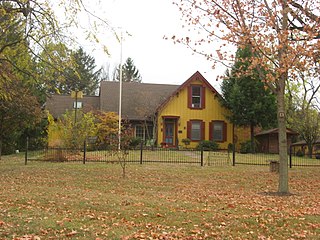
Anderson–Thompson House, also known as Thompson–Schultz House , is a historic home located in Franklin Township, Marion County, Indiana. It was built between about 1855 and 1860, and is a 1+1⁄2-story, ell shaped, Gothic Revival style dwelling. It rests on a low brick foundation, has a steeply-pitched gable roof with ornately carved brackets, and is sheathed in board and batten siding.

The Nicherson–Tarbox House is a historic house in Monticello, Minnesota, United States. It was built in 1889 in a blend Queen Anne and Shingle Style architecture. A barn was moved to the rear of the lot around the turn of the 20th century to serve as a carriage house, now a detached garage. The property, which contained a second outbuilding that is no longer extant, was listed on the National Register of Historic Places in 1979 as the Nicherson–Tarbox House, Shed and Barn for having local significance in the theme of architecture. It was nominated for being a prominent and well-preserved example of Queen Anne and Shingle Style architecture in Monticello.

The Williams-Cole House is a single family home located at 6810 Newburg Road near Durand, Michigan. It was listed on the National Register of Historic Places in 1986.

The Wesley O. Conner House, on Cedartown St. in Cave Spring, Georgia, was built in 1869 by Wesley O. Connor, the Superintendent of the Georgia School for the Deaf. It was listed on the National Register of Historic Places in 1980.






















